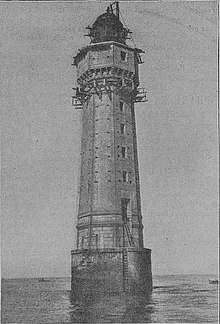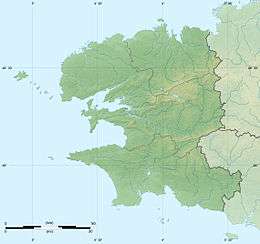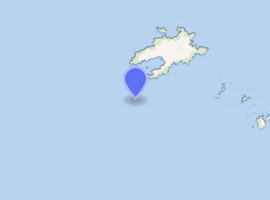La Jument
La Jument ("the mare") is the name of a lighthouse at the Northwestern part of France, Brittany. The lighthouse is built on a rock (that is also called La Jument) about 300 metres from the coast of the island of Ushant, which marks the north-westernmost point of metropolitan France. There is also a very different lighthouse about 3 kilometres to the North, the Nividic lighthouse. Together with the Kreac'h lighthouse, they are the 3 most famous lighthouses of the region.

La Jument in 2007 | |
 La Jument Location in Finistère  La Jument La Jument (France) | |

| |
| Location | Ushant, France (offshore) |
|---|---|
| Coordinates | 48°25′0″N 5°7′59″W |
| Year first constructed | 1911 |
| Year first lit | 1911 |
| Automated | 1991 |
| Foundation | concrete base |
| Construction | stone tower |
| Tower shape | octagonal tower with balcony and lantern |
| Markings / pattern | unpainted tower, red lantern and balcony |
| Tower height | 48 metres (157 ft) |
| Focal height | 36 metres (118 ft) |
| Original lens | Fresnel |
| Current lens | Fresnel |
| Light source | solar power |
| Range | 22 nautical miles (41 km; 25 mi) |
| Characteristic | 3 Fl R 15s 1990 electrification |
| Admiralty number | A1848 |
| NGA number | 113-0024 |
| ARLHS number | FRA-026[1] |
| Heritage | monument historique classé |
History
This section of the coastline of Brittany, the west coast of Northern France, had always been known by sailors to be a rugged and dangerous area. Being the westernmost point of land, it is a heavily trafficked sealane, and also experiences severe weather during much of the year. As a result, the area has experienced many shipwrecks over the centuries: for example, just between 1888 and 1904 thirty-one ships were wrecked there.
Plans to build a lighthouse on La Jument started not long after the wreck of the Glasgow-built steam ship SS Drummond Castle in June, 1896, which had resulted in the deaths of around 250 people. The building works were privately financed by a wealthy Frenchman who had almost died in another shipwreck. Construction began in 1904 but the lighthouse could not be finished until 1911 because of the sea's often challenging conditions.
Guichard's photographs
The lighthouse became well known in 1989, through a series of photographs taken by Jean Guichard.
Over the past century La Jument lighthouse has effectively increased maritime safety in the area, known to the Bretons as Mer d'Iroise or Iroise Sea. However, the waters off Brittany's west coast still remain one of the most dangerous seas in Europe with frequent violent storms, huge waves and strong currents.
One of those infamous storms on the Iroise Sea happened on 21 December 1989. A front of low pressure coming from Ireland brought gale-force winds and huge waves of 20 to 30 metres high which crashed spectacularly against the lighthouse.
The waves smashed through the lower windows of the lighthouse, ripped the front door, flooded the tower and washed away the furniture.
About the same time, photographer Jean Guichard was in Lorient hiring a helicopter to take aerial pictures of the storm. Guichard wanted to fly over the Iroise Sea despite extremely dangerous flying conditions.
The helicopter made it to La Jument and hovered around for Guichard to take shots of the waves pounding the lighthouse. Inside the tower, Théodore Malgorn heard the helicopter and went downstairs to see what was happening. At that very moment, a giant wave rose over the rear of the lighthouse and Guichard took his world-famous shot as the wave smashed against the tower. Malgorn, suddenly realising that a giant wave was about to engulf the structure, rushed back inside just in time to save his life. In an interview he said "If I had been a little further away from the door, I would not have made it back into the tower. And I would be dead today. You cannot play with the sea."[2]
Jean Guichard's 1989 dramatic storm photo shots became an instant hit and earned him the 2nd place in the 1991 World Press Photo award.[3] La Jument appeared on newspapers and magazines all around the world and Guichard went on to publish a best selling book about lighthouses and a collection of poster prints.
La Jument's poster print has sold well over one million copies, making the Breton lighthouse the most famous lighthouse print in the world.
Lighthouses in Brittany have been automated in the past decades and La Jument itself hasn't had a keeper since 1991. For many years Jean Guichard's quest was to portray Brittany's maritime heritage before automation took over. Many of his photos are now considered to hold a historic value and his work is highly respected in Brittany.[4][5]
See also
- List of lighthouses in France
- L'Équipier (Cinema of France: The Light, directed by Philippe Lioret)
References
- Rowlett, Russ. "Lighthouses of France: Northern Finistère". The Lighthouse Directory. University of North Carolina at Chapel Hill. Retrieved January 21, 2016.
- "Uhr Was macht eigentlich... ...Théodore Malgorn?". Der Stern. December 4, 2007. Retrieved July 27, 2018..
- "1991 Photo Contest". World Press Photo. Retrieved 5 July 2015.
- Finnegan, Kathleen (July 2001). "Photographer Who Shot the Wave Appears at Lighthouse Depot".
- "La Jument, Brittany's most famous lighthouse". January 2001.
- (in French) Philip Plisson; Guillaume Plisson et Daniel Charles, Phares majeurs de l'arc Atlantique, 2002, pp. 190–191.
- (in French) Henri Queffélec : Le phare, histoire romancée de la construction du phare de la Jument au suroit d'Ouessant mêlant le travail bien réel du Service des phares et balises et la trame amoureuse d'un marin de Molène et d'une ouessantine. Roman paru aux Presses de la Cité en 1975.
- (in French) Henri Queffélec : La Lumière enchaînée, suite du précédent, histoire du renforcement des foundations du phare de la Jument. Roman paru aux Presses de la Cité en 1976.
External links
| Wikimedia Commons has media related to La Jument lighthouse. |
- (in French) Carte des phares du Finistère (Map of the lighthouses of the département of Finistère)
- The story of the La Jument photos
- Guichard, Jean. "A massive wave that hit a lighthouse off the coast of France in 1989 - the man in the lighthouse survived" (Photo). Retrieved July 27, 2018.
- La Jument Ministère de la Culture (in French)
- Rotation of the lighthouse keepers of the "Jument" (April 1983)